Habitat - YOUR STOMACH!
The only known habitat of Helicobacter pylori is the human stomach and the beginning of the digestive tract. Stomach infections, in terms of numbers of cells, usually reach around 107 to 1010 cells! Specifically, H. pylori inhabits the mucous membrane, which is the pale yellow lining that protects the epithelial cells of the stomach. The bacterium does not invade the epithelial cells beneath the mucosa. The beginning of the digestive tract, that this bacterium less commonly inhabits, is called the duodenum. The duodenum and the stomach are separated by the pylorus, which can also be inhabited by H. pylori. This also happens to be where the species name originates from.
There are other Helicobacter species that inhabit the digestive tract of other vertebrates, such as ferrets, raccoons, swine, sheep, rodents, primates, and many more. It grows best in a pH of 6-7. However, when accompanied by urea, which is found in the digestive tract of humans, it can tolerate much lower pH levels. The bacterium typically grow best at oxygen levels around 5%, which is the oxygen level found in the stomach's mucous layer.
To find
out more about other hosts that Helicobacter species
live in, click on any of the following links:
Bighorn Sheep
Eastern Gorilla
Ring-Tailed Lemur
Chimpanzee
To find out how Helicobacter pylori has adapted to live inside of you, click here.

